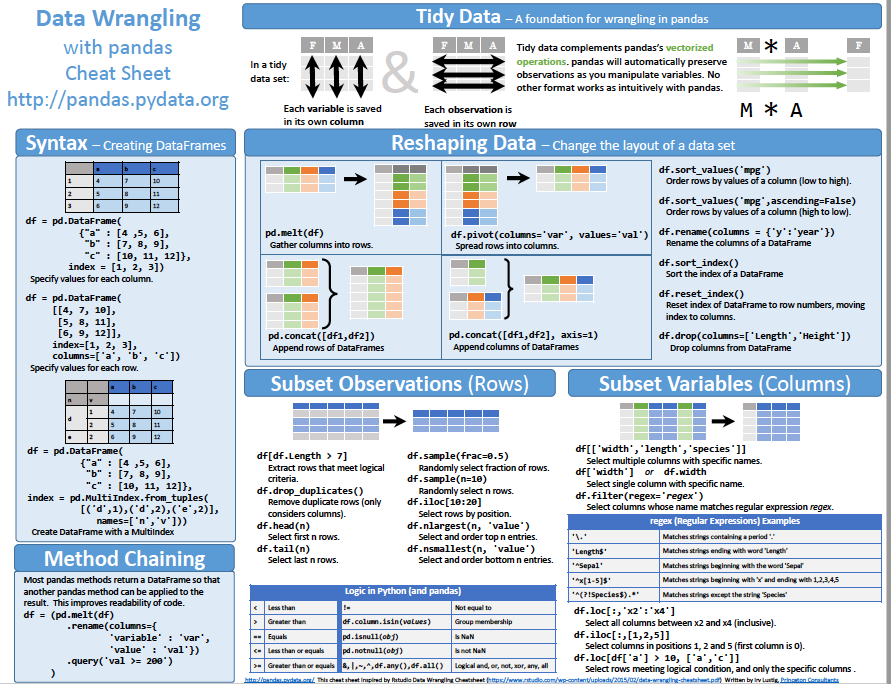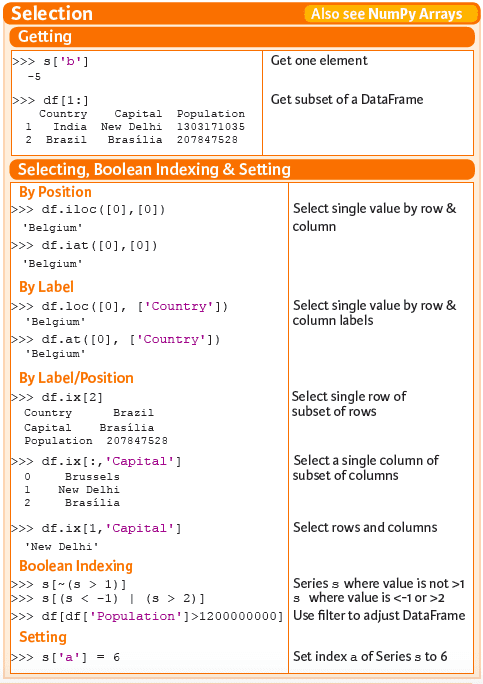Pandas Python Cheat Sheet
- And be sure to check out DataCamp's other cheat sheets, as well. The Pandas library is one of the most preferred tools for data scientists to do data manipulation and analysis, next to matplotlib for data visualization and NumPy, the fundamental library for scientific computing in Python on which Pandas was built.
- Pandas, Numpy, Python Cheatsheet Python notebook using data from Kernel Files 21,941 views 1y ago.
- Pandas Cheat Sheet is a quick guide through the basics of Pandas that you will need to get started on wrangling your data with Python. If you want to begin your data science journey with Pandas, you can use it as a handy reference to deal with the data easily.
- Pandas Python Cheat Sheet Free
- Pandas Python Cheat Sheet Answers
- Python Pandas Cheat Sheet Pdf
- Python Pandas Plot Cheat Sheet
- Pandas Python Cheat Sheet Examples
- Pandas Python Cheat Sheet For Beginners
- Pandas Python Cheat Sheet Example
To excel data analysis/data science/machine learningin Python, Pandasis a library you need to master. Here is a cheat sheetof some of the most used syntax that you probably don’t want to miss. The Pandas package is the most imperativetool in Data Science and Analysis working in Python nowadays.
Being able to look up and use functions fast allows us to achieve a certain flow when writing code. So I’ve created this cheatsheet of functions from python pandas.
This is not a comprehensive list but contains the functions I use most, an example, and my insights as to when it’s most useful.
Load CSV
If you want to run these examples yourself, download the Anime recommendation dataset from Kaggle, unzip and drop it in the same folder as your jupyter notebook.
Next Run these commands and you should be able to replicate my results for any of the below functions.
Convert a CSV directly into a data frame. Sometimes loading data from a CSV also requires specifying an encoding (ie:encoding='ISO-8859–1'). It’s the first thing you should try if your data frame contains unreadable characters.
Another similar function also exists called pd.read_excel for excel files.
Build data frame from inputted data
Useful when you want to manually instantiate simple data so that you can see how it changes as it flows through a pipeline.
Copy a data frame
Useful when you want to make changes to a data frame while maintaining a copy of the original. It’s good practise to copy all data frames immediately after loading them.
Save to CSV
This dumps to the same directory as the notebook. I’m only saving the 1st 5 rows below but you don’t need to do that. Again, df.to_excel() also exists and functions basically the same for excel files.
Get top or bottom n records
Display the first n records from a data frame. I often print the top record of a data frame somewhere in my notebook so I can refer back to it if I forget what’s inside.
Count rows
This is not a pandas function, but len() counts rows and can be saved to a variable and used elsewhere.
Count unique rows
Count unique values in a column:
Get data frame info
Useful for getting some general information like header, number of values and datatype by column. A similar but less useful function is df.dtypes which just gives column data types.
Get statistics
Really useful if the data frame has a lot of numeric values. Knowing the mean, min and max of the rating column give us a sense of how the data frame looks overall.
Get counts of values
Get a list or series of values for a column
This works if you need to pull the values in columns into x and y variables so you can fit a machine learning model.
Pandas Python Cheat Sheet Free
Get a list of index values
Pandas Python Cheat Sheet Answers
Create a list of values from index.

Get a list of column values
Append new column with a set value
I do this on occasion when I have test and train sets in 2 separate data frames and want to mark which rows are related to what set before combining them.
Create new data frame from a subset of columns
Useful when you only want to keep a few columns from a giant data frame and don’t want to specify each that you want to drop.
Drop specified columns
Python Pandas Cheat Sheet Pdf
Useful when you only need to drop a few columns. Otherwise, it can be tedious to write them all out and I prefer the previous option.
Add a row with sum of other rows
We’ll manually create a small data frame here because it’s easier to look at. The interesting part here is df.sum(axis=0) which adds the values across rows. Alternatively df.sum(axis=0) adds values across columns.
The same logic applies when calculating counts or means, ie: df.mean(axis=0).
Concatenate 2 dataframes
Use this if you have 2 data frames with the same columns and want to combine them.
Here we split a data frame in 2 them add them back together.
Merge dataframes
This functions like a SQL left join, when you have 2 data frames and want to join on a column.
Retrieve rows with matching index values
The index values in anime_modified are the names of the anime. Notice how we’ve used those names to grab specific columns.
Retrieve rows by numbered index values

This differs from the previous function. Using iloc, the 1st row has an index of 0, the 2nd row has an index of 1, and so on… even if you’ve modified the data frame and are now using string values in the index column.
Use this is you want the first 3 rows in a data frame.
Get rows
Retrieve rows where a column’s value is in a given list. anime[anime['type'] 'TV'] also works when matching on a single value.
Slice a dataframe

This is just like slicing a list. Slice a data frame to get all rows before/between/after specified indices.
Filter by value
Filter data frame for rows that meet a condition. Note this maintains existing index values.
sort_values
Sort data frame by values in a column.
Python Pandas Plot Cheat Sheet
Groupby and count
Count number of records for each distinct value in a column.
Groupby and aggregate columns in different ways
Note I added reset_index() otherwise the type column becomes the index column — I recommend doing the same in most cases.
Create a pivot table
Nothing better than a pivot table for pulling a subset of data from a data frame.

Note I’ve heavily filtered the data frame so it’s quicker to build the pivot table.
Set NaN cells to some value
Pandas Python Cheat Sheet Examples
Set cells with NaN value to 0 . In the example we create the same pivot table as before but without fill_value=0 then use fillna(0) to fill them in afterwards.
Pandas Python Cheat Sheet For Beginners
Sample a data frame
I use this all the time taking a small sample from a larger data frame. It allows randomly rearranging rows while maintaining indices if frac=1
Iterate over row indices
Pandas Python Cheat Sheet Example
Iterate over index and rows in data frame.
